arranged by Travelwild as part of our tour. Float plane is the only practical way to get there.

The lodge includes a buffet meal service, a bar, and a great fireplace with seating for 12 around it. there is also an area with three small couches and a coffee table.
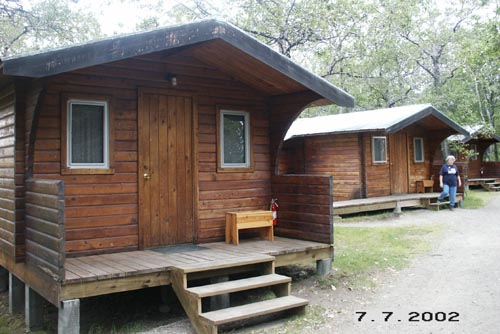
There are six cabins at the Brooks River Lodge. Each is about 12 feet
square and has bunk beds for up to four people. Each has a toilet, lavatory,
and shower, and an oil-fired heater. There is no closet. We had a space
under the beds in our cabin large enough for suitcases. In another
cabin, drawers were under the beds allowing suitcases to be unloaded, but
no space for storing the cases. They slept with the cases on their beds. I
only saw in two cabins.
Travelwild occupied five of the six cabins for 7-9 July. We were divided with three men in each of two cabins, and twelve women in the other three. In addition to the six cabins, there is a campground with an electrified fence to keep bears out.
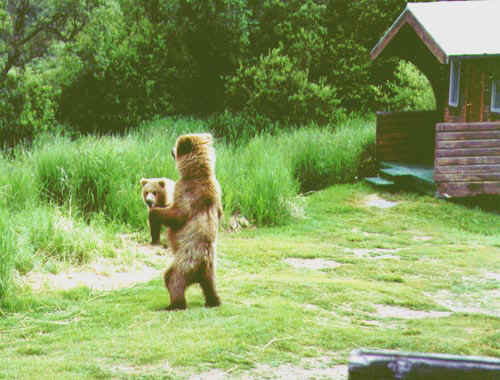
Bears in the cabin area were common every day. This is two yearling cubs
that paid a quick visit.

A trail from the lodge, about a quarter mile long, leads to a floating bridge across the Brooks River. After crossing the river, an elevated viewing stand is available for watching bears in this popular area where the river empties into Naknek Lake.
The bridge area of the river is a popular fishing spot, and many large salmon are caught there daily. The fishermen must also move to the viewing stand if a bear approaches. If a fish is hooked and a bear approaches, the angler must break their line immediately and not land the fish. The bridge is a popular place to watch the salmon swim through the shallow water.

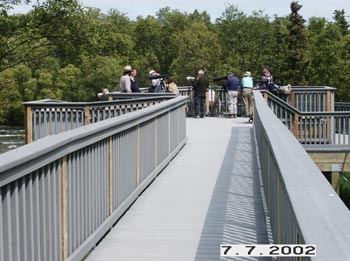
About 3/4 mile from the bridge you reach an elevated walkway that leads to two more viewing platforms. The first of these is the Riffle platform.
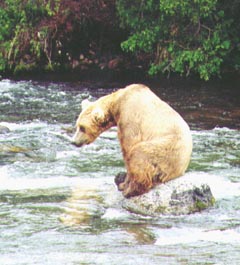
The riffle area is very popular with young male bears.

About 200 yards beyond the Riffle platform is the Falls viewing platform. This platform is often crowded, as shown here, and a ranger will limit the time an individual spends on the platform to about an hour during the crowded times. Crowding starts about 10 AM, and ends at mid afternoon. Each morning several floatplanes arrive with visitors that make a mid-day visit and then leave. I am guessing that 20 to 30 of these mid-day visitors arrive each day, but there could be more. About 15 people can comfortably watch bears at one time from the two levels of the Falls platform. About 20 people make it crowded. There is a covered seating area where the Riffle platform walkway joins the Falls walkway where bear watchers can wait a turn on the Falls platform. There are no toilet facilities except at the lodge.

The falls is the place everyone goes to see bears. This is the place where bears at the top of the falls catch salmon in midair as they attempt to jump up the falls to reach their spawning area. This is also the place where large males are present. Smaller males, like the light colored one at above right, keep away from the larger males. Several bears have favorite places, and they all seem to know their pecking order. At times one bear would approach another that had a fish, and the one with the fish would would either drop it, or quickly leave the water with it. Leaving the water did not always prevent the other bear from following and taking the fish, but it sometimes did.
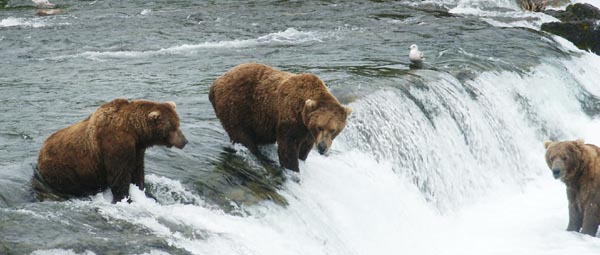
The bear in the center, above, was in the best spot for this afternoon when there were few fish jumping. When he caught a fish, he would move to shallow water to eat, and the bear on the left would move over and "save his spot" until he returned.
Most of the above pictures were made with a Minolta Dimage s404 digital camera, 35-140mm lens equivalent. The second, fourth, and sixth pictures from the top were made with a Tamron 28-200mm lens on a 35mm Canon camera. Good pictures can be made without a long telephoto lens, and even a throw away camera if that is all you have. I was not successful at catching a shot with the bear making a mid-air catch with a still camera, but did capture it several times on video.
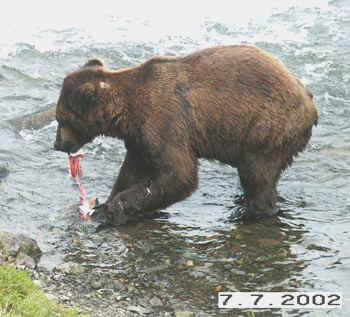
Notice the cuts on the front leg and behind the head. Several bears had cuts. These were probably inflicted in mating fights a few weeks earlier. When we were there, no fights occurred, but some "jawing" did happen between bears to settle which was the dominant bear.

